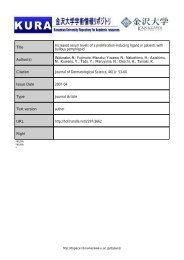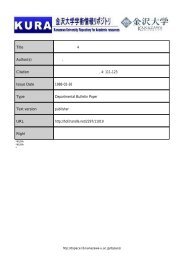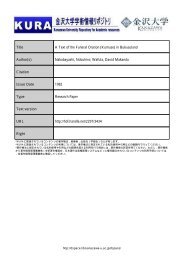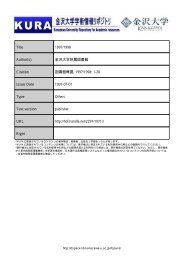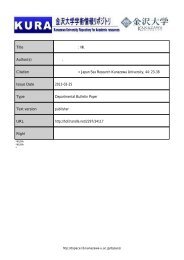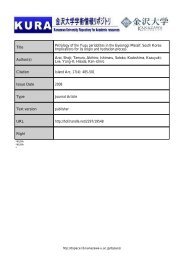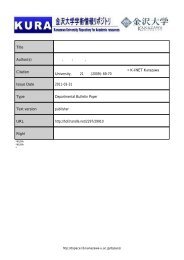Title The Study on Myanmar trade ware:Martaban Jar and ... - 金沢大学
Title The Study on Myanmar trade ware:Martaban Jar and ... - 金沢大学
Title The Study on Myanmar trade ware:Martaban Jar and ... - 金沢大学
Create successful ePaper yourself
Turn your PDF publications into a flip-book with our unique Google optimized e-Paper software.
<strong>金沢大学</strong>考古学紀要 30 2009, 101-136. <str<strong>on</strong>g>The</str<strong>on</strong>g> study of <strong>Myanmar</strong> <strong>trade</strong> <strong>ware</strong> : <strong>Martaban</strong> jar <strong>and</strong> white dish<br />
grains, glazing method <strong>and</strong> pattern of decorated designs are<br />
comm<strong>on</strong>ly the same until at present. But the sizes of minerals<br />
or grains mixed inside the paste of fabric are slightly different<br />
am<strong>on</strong>g the sites in Japan, Tahlaing-k<strong>on</strong>e <strong>and</strong> Ko Ohn Hlaing<br />
kilns from Upper <strong>Myanmar</strong>. <str<strong>on</strong>g>The</str<strong>on</strong>g> black grain sizes from the<br />
sites in Japan are comm<strong>on</strong>ly larger than the grain size of Upper<br />
<strong>Myanmar</strong> glazed jars.<br />
<str<strong>on</strong>g>The</str<strong>on</strong>g> same characteristic of using the same clay at the decorated<br />
design of white slip butt<strong>on</strong>s <strong>and</strong> the body fabric is found at the<br />
glazed jar of Bagan Museum, Bagan.M-2 <strong>and</strong> Talaing-k<strong>on</strong>e jar,<br />
Upper <strong>Myanmar</strong>.<br />
This phenomen<strong>on</strong> menti<strong>on</strong>s to assume whether Bagan glazed jar,<br />
Bagan.M-2 would be from the producti<strong>on</strong> of M<strong>and</strong>alay regi<strong>on</strong>,<br />
Upper <strong>Myanmar</strong>. However, these jars would be produced from<br />
different age or different kilns. Although the same clay was used<br />
in all parts of the glazed jars of Bagan Museum <strong>and</strong> Talaingk<strong>on</strong>e<br />
kiln, the shape style is different between them. <str<strong>on</strong>g>The</str<strong>on</strong>g> mouth,<br />
neck <strong>and</strong> body are with the similar styles of <strong>trade</strong> jars <strong>and</strong> of<br />
lower <strong>Myanmar</strong> jars.<br />
According to the <strong>Myanmar</strong> inscripti<strong>on</strong> of Bagan period, Luce<br />
<strong>and</strong> Gutman menti<strong>on</strong>ed that at the end of the 13th century<br />
(1291) when the Bagan court fled south to Twante (Tala) before<br />
the advance of the M<strong>on</strong>gols. Queen Acaw (Asaw) ordered the<br />
Cakyap potters of Tala Twante) circle to supply pots (Luce<br />
1969, Pamela Gutman 1978).<str<strong>on</strong>g>The</str<strong>on</strong>g> glazed jar of Bagan.M-1 was<br />
temporarily dated from about 11th century, <strong>and</strong> Bagan.M-2<br />
would be between 11th to 13th century which were comm<strong>on</strong>ly<br />
presumed during the time of Bagan Period. Indeed, it is<br />
complexity for dating these jars. According to the typological<br />
characteristic, this type of glazed jar, Bagan.M-2 would be<br />
assumed as early as after Bagan Period or probable about the<br />
end of 17th century to half of 18th century.<br />
3. Bagan kilns <strong>and</strong> glazed jars from the excavati<strong>on</strong> of these<br />
Kilns<br />
Bagan updraft kilns are not for manufacturing utensil ceramics.<br />
According to the previous research, kilns would have been used<br />
for making glaze or for glass <strong>ware</strong>.<br />
3.1 Historical setting<br />
Bagan is located in central plain, <strong>on</strong> the left bank of<br />
Ayeyarwady (Irrawaddy) River, about 450 kilometres north<br />
of Yang<strong>on</strong>. <str<strong>on</strong>g>The</str<strong>on</strong>g> first kingdom of <strong>Myanmar</strong> was founded in<br />
Bagan city, <strong>and</strong> its classical period was between 11th <strong>and</strong> 13th<br />
centuries. Its first king, Anawrahta (AD 1044-1077) rapidly<br />
exp<strong>and</strong>ed his kingdom, attacking the M<strong>on</strong> in the south at That<strong>on</strong><br />
<strong>and</strong> capturing its king Manuha, whom he brought back to Bagan<br />
<strong>and</strong> settled at Myinkaba, a kilometer south of the city wall. Not<br />
− 113 −<br />
<strong>on</strong>ly King Manuha <strong>and</strong> his attendants have been brought to<br />
Bagan but also the artisans <strong>and</strong> craftsmen a suppositi<strong>on</strong> relevant<br />
to the matter of ceramics. By the 10th century, glazed bricks<br />
were used in buildings at Bagan <strong>and</strong> the following century<br />
glazed plaques <strong>and</strong> fitting were decorated in the Buddhist<br />
m<strong>on</strong>uments. Most of the glazed plaques are inscribed with<br />
the M<strong>on</strong> script, but by the late 12th century use of <strong>Myanmar</strong><br />
language had begun to dominate. <str<strong>on</strong>g>The</str<strong>on</strong>g> M<strong>on</strong>gol invasi<strong>on</strong> of 1287<br />
led to the decline of Bagan.<br />
3.1-1 Previous Research <strong>on</strong> Bagan Kilns<br />
A several numbers of ancient kilns could be found at the regi<strong>on</strong><br />
of Bagan ancient city. In presence, seven kilns were c<strong>on</strong>firmed<br />
<strong>and</strong> had been excavated. <str<strong>on</strong>g>The</str<strong>on</strong>g> first recorded archaeology <strong>on</strong><br />
kilns at Bagan is an excavati<strong>on</strong> c<strong>on</strong>ducted in 1963 by Sergio<br />
Della Strologo <strong>and</strong> U Kyaw Nyein. <str<strong>on</strong>g>The</str<strong>on</strong>g>y produced a brief<br />
unpublished statement titled “Report <strong>on</strong> Bagan Trip for Analysis<br />
of Glazing Kiln. In 1999, the archaeological team included<br />
from Archaeology Department, Ministry of Culture <strong>and</strong> D<strong>on</strong><br />
Hein, Australian ceramic researcher re-excavated kiln#1 for the<br />
purpose to verify the Strologo-Nyein report, <strong>and</strong> other kilns.<br />
According to the previous excavated research, Strologo <strong>and</strong><br />
Nyein reported that many glazed potsherds with the glazed<br />
colours of turquoise blue, <strong>and</strong> olive green, a brownish purple<br />
<strong>and</strong> emerald green, a transparent clear glaze <strong>and</strong> opaque light<br />
green. Most of the glazes found in kiln# 1 were <strong>on</strong> pottery<br />
pieces <strong>and</strong> there were not found relief fragments or discarded<br />
glazed bricks.<br />
And some sherds excavated from kiln#1 are very similar to a<br />
few cerem<strong>on</strong>ial pots with semi-transparent olive green colour<br />
glaze which can be seen in Bagan Museum. But all of the other<br />
glazes are new. <str<strong>on</strong>g>The</str<strong>on</strong>g> Bagan glazes used in the pagodas were all<br />
opaque glazes whose colours ran from green to greenish blue<br />
with some yellow <strong>and</strong> cream colour glazes. N<strong>on</strong>e of the Bagan<br />
glazes <strong>on</strong> the architecture were transparent. <str<strong>on</strong>g>The</str<strong>on</strong>g>y were shiny <strong>on</strong><br />
the surface <strong>and</strong> have become matt due to weathering.<br />
Hein thoroughly reported about the excavated kilns. Glazed<br />
potsherds <strong>and</strong> glass materials such as beads, tube, lumps were<br />
comm<strong>on</strong>ly found in the excavated kilns. He assumed that the<br />
small kilns would be used particularly for producing glass.<br />
However, the first excavators, Strilogo <strong>and</strong> Nyein did not<br />
reported that c<strong>on</strong>cerning the findings of glass materials, but<br />
they reported about the structure of kiln’s site <strong>and</strong> they found<br />
different colour glazed sherds of jars as comm<strong>on</strong> finds.<br />
3.1-2 Bagan Kilns <strong>and</strong> the remnant collected finds (figure 15)<br />
Bagan kilns are with updraft kiln type, <strong>and</strong> with two different<br />
forms of circular shape <strong>and</strong> horseshoe shape. Kiln#1 <strong>and</strong> #7 are<br />
circular in shape with the same size. Am<strong>on</strong>g the five smaller




